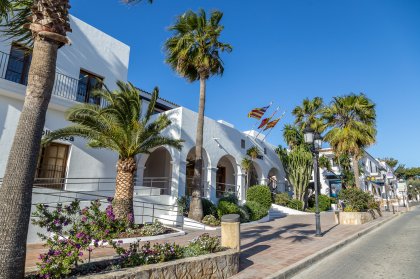History can be very dry, depending on how and what is reported from the past. Take a look at this, it's the history of one of Ibiza's many watchtowers, the Torre d'en Rovira, built on a westerly point between Cala Bassa and Cala Conta.

“The towers date back to a period when Barbary pirates raided Ibiza in a non-alcoholic frenzy of pillaging and carrying off the natives into slavery. The idea of the towers was to form a defensive network which gave cannon coverage of all the coastline.
The Torre de'n Rovira was started in 1756 by local engineer Ballester, finished in 1763 and is the biggest tower constructed in that period. Together with the cannons on San Antonio church, it commanded the entrance to San Antonio Bay and took its name from the bloke in charge of the defence of the area – Rovira.”

The story of the tower gets interesting in the 20th century when it was bought as a summer home by a Catalan painter, Evelio Torent Marsans, and his wife. An interesting article in the Diario de Ibiza gives accounts of the period, when they were considered a little eccentric. I can't help thinking of their contemporaries, Mr and Mrs Salvador Dali, when I read what they got up to in their 1920's stays in Ibiza.
They set about creating their own little kingdom, the self proclaimed Caliphate of  Es Pallaret (the name of the nearest small island) with Evelio as Caliph, and wife Consuela as Calipha. The area
around the house was chock full of monuments and creations made from rocks and stones, almost like a mini village which had street and places names like 'Capitol,' 'Circo Romano,' and 'Pila
Milagrosa.'
Es Pallaret (the name of the nearest small island) with Evelio as Caliph, and wife Consuela as Calipha. The area
around the house was chock full of monuments and creations made from rocks and stones, almost like a mini village which had street and places names like 'Capitol,' 'Circo Romano,' and 'Pila
Milagrosa.'
There was even a 'restaurant' for the lizards of the Caliphate, where, at certain times of the day, the lizards would come scuttling like Pavlov's dogs at the sound of a bell to feed on tomatoes and so on, put there by the Caliph.
Their fame soon spread and interested visitors would arrive by boat or after a long trek through the country. They were welcomed by the Caliph in an official ceremony which involved him hoisting a flag up the flagpole while she saluted them with both hands. They were then invited to sign the 'Book of Gold,' the official visitors book of the Caliphate.
Their visits became less frequent in the 30's and Torent Marsans died in Barcelona in 1940. However, visitors can still see this type of creative eccentricity in action today by visiting Cala Bassa where there area series of shrines built by a man living in a nearby cave.
